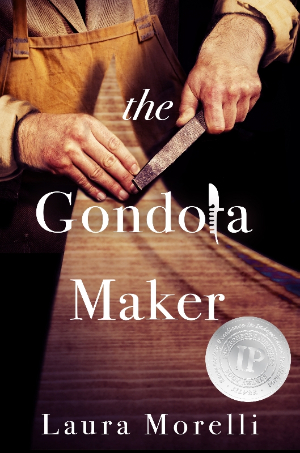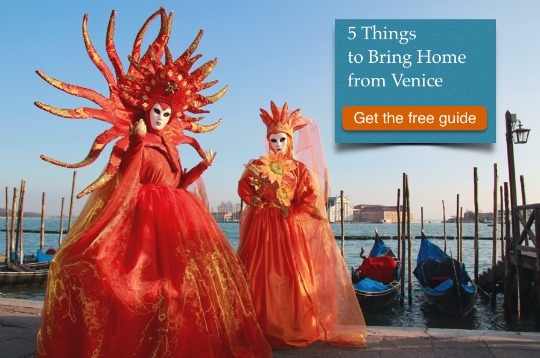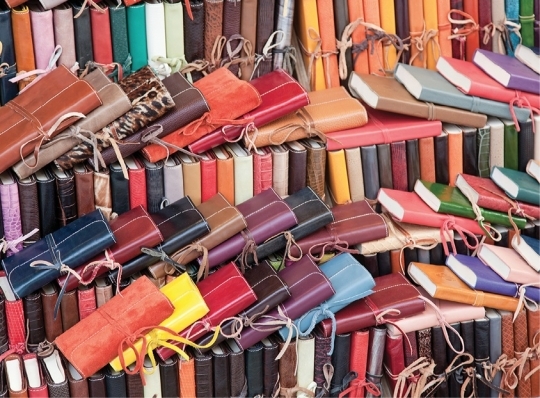Laura Morelli's Blog, page 4
May 15, 2016
Naples Italy: A Jewel in the Crown?
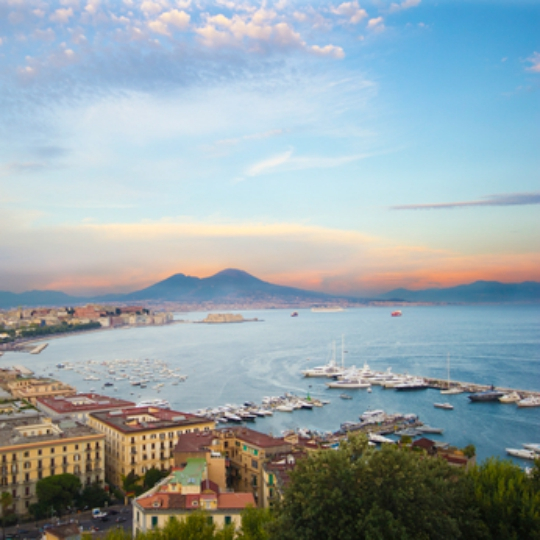
Alexandre Dumas, author of The Three Musketeers, called Naples Italy “the flower of paradise,” and a fellow French writer, Gustave Flaubert, referred to it as “a Mediterranean Paris.” The German author Goethe was so awestruck by the beauty and allure of the city that he could only sum it up by saying, “See Naples and die.”
Today, these two-hundred-year-old accolades are lost on many first-time visitors, who exit the Napoli Centrale train station only to be met by disreputable cab drivers, fast-talking hawkers, pickpockets, and more sophisticated swindlers. A glance beyond this rag-tag welcoming committee reveals traffic-clogged avenues, graffiti-covered buildings, and steaming piles of uncollected garbage. This first impression does little to counter the city’s shady reputation, and it’s no wonder that some first-time visitors to Naples turn around and get back on the train.
But not so fast. If you’re intrepid enough to pass this trial-by-fire initiation to Napoli, then you’re ready to peel back the city’s gritty layers to discover the charisma that so captivated travelers of centuries past. If you carry a sense of humor and adventure, you will embark on a journey to uncover the gems in the crown of Southern Italy’s artisanal traditions. Read on…
Have you discovered the unique beauty and history of Napoli? Drop a comment below. I love to hear your stories!
.fusion-fullwidth-1 {
padding-left: 0px !important;
padding-right: 0px !important;
}
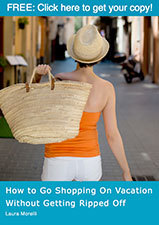 Join me!
Join me!Be the first to receive exclusive content, news, contests, and reader appreciation gifts. Sign up for my Reader’s Group and download a free copy of my guide, How to Go Shopping on Vacation Without Getting Ripped Off.
.fusion-button.button-1 .fusion-button-text, .fusion-button.button-1 i {color:#ffffff;}.fusion-button.button-1 {border-width:0px;border-color:#ffffff;}.fusion-button.button-1 .fusion-button-icon-divider{border-color:#ffffff;}.fusion-button.button-1:hover .fusion-button-text, .fusion-button.button-1:hover i,.fusion-button.button-1:focus .fusion-button-text, .fusion-button.button-1:focus i,.fusion-button.button-1:active .fusion-button-text, .fusion-button.button-1:active{color:#000000;}.fusion-button.button-1:hover, .fusion-button.button-1:focus, .fusion-button.button-1:active{border-width:0px;border-color:#000000;}.fusion-button.button-1:hover .fusion-button-icon-divider, .fusion-button.button-1:hover .fusion-button-icon-divider, .fusion-button.button-1:active .fusion-button-icon-divider{border-color:#000000;}.fusion-button.button-1{background: #dd9933;
background-image: -webkit-gradient( linear, left bottom, left top, from( #c97800 ), to( #dd9933 ) );
background-image: -webkit-linear-gradient( bottom, #c97800, #dd9933 );
background-image: -moz-linear-gradient( bottom, #c97800, #dd9933 );
background-image: -o-linear-gradient( bottom, #c97800, #dd9933 );
background-image: linear-gradient( to top, #c97800, #dd9933 );}.fusion-button.button-1:hover,.button-1:focus,.fusion-button.button-1:active{background: #c97800;
background-image: -webkit-gradient( linear, left bottom, left top, from( #dd9933 ), to( #c97800 ) );
background-image: -webkit-linear-gradient( bottom, #dd9933, #c97800 );
background-image: -moz-linear-gradient( bottom, #dd9933, #c97800 );
background-image: -o-linear-gradient( bottom, #dd9933, #c97800 );
background-image: linear-gradient( to top, #dd9933, #c97800 );}.fusion-button.button-1{width:auto;}GET MY FREE BOOK.fusion-fullwidth-2 {
padding-left: 20px !important;
padding-right: 20px !important;
}Explore my books:
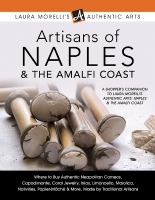
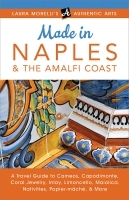
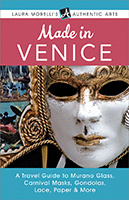
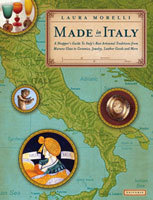 Learn more about Laura Morelli’s Authentic Arts guidebook series.
Learn more about Laura Morelli’s Authentic Arts guidebook series. The post Naples Italy: A Jewel in the Crown? appeared first on Laura Morelli: Art History, Art Historical Fiction, Authentic Travel.
April 15, 2016
Artisans of Rome
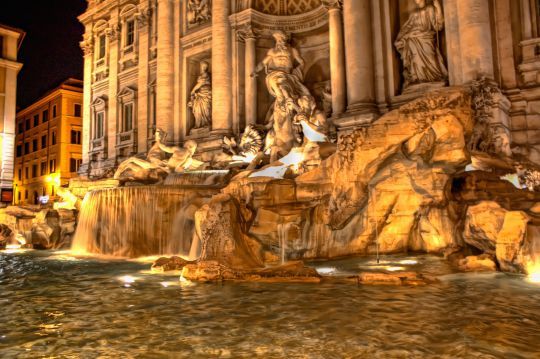
Rome is nothing if not impressive. The scale and density of the city’s ancient monuments, Baroque architecture, and public works of art provide a feast for the eyes, but they also overshadow the city’s unjustly overlooked artisans of Rome. Traditional workers of metal, marble, ceramic, glass, and other media are tucked into neighborhoods across the Eternal City. Memorable discoveries and a powerful, palpable connection to the past await those who take the time to locate these unsung masters.
Historically, many Roman artisans occupied the working-class neighborhoods on the southern bank of the Arno. The Trastevere section of town has housed shoemakers, glass blowers, sculptors, marble workers, and other tradespeople since ancient times. Today, the neighborhood retains the flavor of an artisan neighborhood, but small workshops occupy nearly every quarter of the city.
One of the most enduring craft traditions of Rome is the working of gold, silver, and other metals. The ancient Romans inherited a rich tradition of metalsmithing from the Greeks and Etruscans. These tradespeople passed their skills from father to son, master to apprentice, over many centuries.
If you can resist the allure of the many jewelry shop windows and instead head to a good artisan goldsmith with a workbench set up inside the studio, you may be lucky enough to watch small masterpieces in development. If you’re serious about coming home with an authentic piece of Roman gold, make an appointment with an artisan goldsmith, and collaborate on the design of your dreams. You’ll go home with a tiny treasure you will value as much for its superb craftsmanship as for its connection to the ancient past. A few of the city’s finest goldsmiths are clustered between the Colosseum and Vatican City (try the Via del Clementino, the Campo Marzio, and surrounding streets).
Roman marble workers also continue the traditions of their ancestors, creating stunning inlaid furniture, pavements, large-scale sculpture and smaller decorative works that would be at home in any ancient Roman villa. Today, marble workers cluster along the via dei Coronari between Piazza Navona and the Tevere. Antique pieces can be uncovered in the shops along the via del Governo Vecchio.
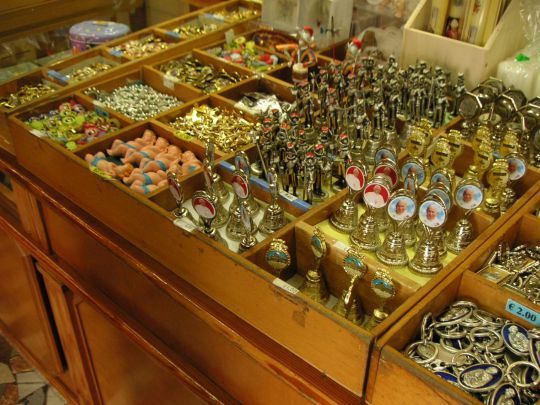
Heart of the Roman Catholic world, shops in Rome spill over with rosaries, ex-votos, statues of saints, and many other devotional objects. Naturally, many of these shops cluster around Vatican City. If a religious souvenir is on your list, take the time to locate one with artisans crafting the work on site, and you will be rewarded with a one-of-a-kind memento of your trip and an appreciation for the work that has gone into it.
To truly appreciate the heritage of Roman craftsmanship, visit one of the city’s excellent museums. For example, the Musei Capitolini and the Museo Etrusco Gregoriano, part of the Vatican Museums, carry impressive collections of Etruscan and Roman jewelry. If you’re a fan of all Italian craftsmanship, it’s worth the trip to the outskirts of the city to see the Museo delle Arti e Tradizioni Popolari, a treasure trove of traditional objects from every region of Italy.
Have you discovered any great artisans in your travels to Italy? Drop a comment below. I love to hear your stories!
.fusion-fullwidth-1 {
padding-left: 0px !important;
padding-right: 0px !important;
}
 Join me!
Join me!Be the first to receive exclusive content, news, contests, and reader appreciation gifts.
.fusion-button.button-1 .fusion-button-text, .fusion-button.button-1 i {color:#ffffff;}.fusion-button.button-1 {border-width:0px;border-color:#ffffff;}.fusion-button.button-1 .fusion-button-icon-divider{border-color:#ffffff;}.fusion-button.button-1:hover .fusion-button-text, .fusion-button.button-1:hover i,.fusion-button.button-1:focus .fusion-button-text, .fusion-button.button-1:focus i,.fusion-button.button-1:active .fusion-button-text, .fusion-button.button-1:active{color:#000000;}.fusion-button.button-1:hover, .fusion-button.button-1:focus, .fusion-button.button-1:active{border-width:0px;border-color:#000000;}.fusion-button.button-1:hover .fusion-button-icon-divider, .fusion-button.button-1:hover .fusion-button-icon-divider, .fusion-button.button-1:active .fusion-button-icon-divider{border-color:#000000;}.fusion-button.button-1{background: #dd9933;
background-image: -webkit-gradient( linear, left bottom, left top, from( #c97800 ), to( #dd9933 ) );
background-image: -webkit-linear-gradient( bottom, #c97800, #dd9933 );
background-image: -moz-linear-gradient( bottom, #c97800, #dd9933 );
background-image: -o-linear-gradient( bottom, #c97800, #dd9933 );
background-image: linear-gradient( to top, #c97800, #dd9933 );}.fusion-button.button-1:hover,.button-1:focus,.fusion-button.button-1:active{background: #c97800;
background-image: -webkit-gradient( linear, left bottom, left top, from( #dd9933 ), to( #c97800 ) );
background-image: -webkit-linear-gradient( bottom, #dd9933, #c97800 );
background-image: -moz-linear-gradient( bottom, #dd9933, #c97800 );
background-image: -o-linear-gradient( bottom, #dd9933, #c97800 );
background-image: linear-gradient( to top, #dd9933, #c97800 );}.fusion-button.button-1{width:auto;}GET MY FREE BOOK.fusion-fullwidth-2 {
padding-left: 20px !important;
padding-right: 20px !important;
}Explore my books:
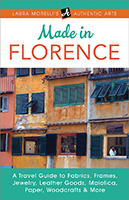
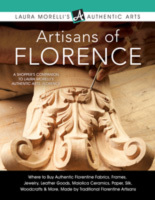
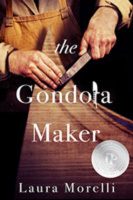
 Learn more about Laura Morelli’s Authentic Arts guidebook series.
Learn more about Laura Morelli’s Authentic Arts guidebook series. The post Artisans of Rome appeared first on Laura Morelli: Art History, Art Historical Fiction, Authentic Travel.
April 3, 2016
Which of these men is Luca?
I’m watching huge, wet April snowflakes fall outside the window of my study this morning! It’s a good day to brew some tea and work on my latest project: producing an audiobook edition of The Gondola Maker, my historical novel set in 16th-century Venice.
I am a big fan of audiobooks and I know many of you are too. I’m looking forward to getting the audio version out for those of you who enjoy books in the car, at the gym, while walking the dog or doing chores.
I’ve had a wonderful response to my call for a professional narrator to portray the voice of Luca Vianello, the 22-year-old son of the most renowned gondola maker in Renaissance Venice. If you have a few minutes to listen to the following audio clips, I would love your feedback!
Who is the voice of Luca? Click the links below to hear the auditions:
Comment below and let me know which narration you like best.
I am so grateful for your feedback. Thank you, friends, and buon ascolto (happy listening)!

The post Which of these men is Luca? appeared first on Laura Morelli: Art History, Art Historical Fiction, Authentic Travel.
March 15, 2016
The Construction of Venice
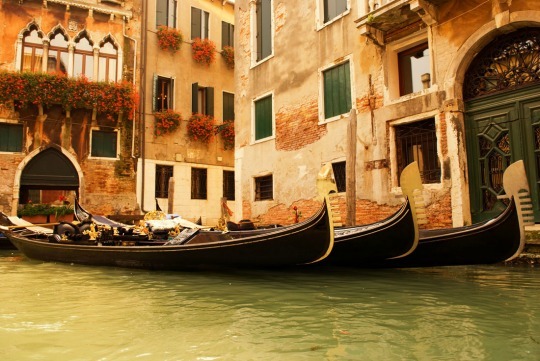
I had had my dreams of Venice. But nothing that I had dreamed was as impossible as what I found.
―ARTHUR SYMONS, CITIES, 1903

Venice rises from a marshy Adriatic lagoon like a surreal vision: a complicated jumble of meandering canals, mosaic-encrusted churches, gothic palace façades, and candy-striped gondola moorings. If you had no prior knowledge of Venice and heard someone describe it, you might find it hard to believe they were telling the truth.
This “impossible” city is not a land mass at all, but rather a cluster of some one hundred shifting islands linked by more than four hundred bridges and canals. The entire built environment of Venice—from the humblest coffee shop to the Basilica of San Marco—stands on a foundation of wooden pilings driven one after another, side by side, vertically down into the water, into the mud.

This unlikely way of constructing a city began during the perilous years of the early Middle Ages, when people sought protection among the lagoon islands from potential attackers. As the centuries passed and the population grew, the locals continued to drive pilings into the marshes to build their city. The wood did not rot because it was not exposed to oxygen; instead, it petrified into a hardened, stone-like foundation upon which sat even the most extravagant buildings constructed during the heyday of the Venetian Republic, between the fourteenth and seventeenth centuries.
Have you discovered a surprise in your travels to Venice? Drop a comment below. I love to hear your stories!
 .fusion-fullwidth-1 {
.fusion-fullwidth-1 {
padding-left: 0px !important;
padding-right: 0px !important;
}  Join me!
Join me!
.fusion-button.button-1 .fusion-button-text, .fusion-button.button-1 i {color:#ffffff;}.fusion-button.button-1 {border-width:0px;border-color:#ffffff;}.fusion-button.button-1 .fusion-button-icon-divider{border-color:#ffffff;}.fusion-button.button-1:hover .fusion-button-text, .fusion-button.button-1:hover i,.fusion-button.button-1:focus .fusion-button-text, .fusion-button.button-1:focus i,.fusion-button.button-1:active .fusion-button-text, .fusion-button.button-1:active{color:#000000;}.fusion-button.button-1:hover, .fusion-button.button-1:focus, .fusion-button.button-1:active{border-width:0px;border-color:#000000;}.fusion-button.button-1:hover .fusion-button-icon-divider, .fusion-button.button-1:hover .fusion-button-icon-divider, .fusion-button.button-1:active .fusion-button-icon-divider{border-color:#000000;}.fusion-button.button-1{background: #dd9933;
background-image: -webkit-gradient( linear, left bottom, left top, from( #c97800 ), to( #dd9933 ) );
background-image: -webkit-linear-gradient( bottom, #c97800, #dd9933 );
background-image: -moz-linear-gradient( bottom, #c97800, #dd9933 );
background-image: -o-linear-gradient( bottom, #c97800, #dd9933 );
background-image: linear-gradient( to top, #c97800, #dd9933 );}.fusion-button.button-1:hover,.button-1:focus,.fusion-button.button-1:active{background: #c97800;
background-image: -webkit-gradient( linear, left bottom, left top, from( #dd9933 ), to( #c97800 ) );
background-image: -webkit-linear-gradient( bottom, #dd9933, #c97800 );
background-image: -moz-linear-gradient( bottom, #dd9933, #c97800 );
background-image: -o-linear-gradient( bottom, #dd9933, #c97800 );
background-image: linear-gradient( to top, #dd9933, #c97800 );}.fusion-button.button-1{width:auto;}GET MY FREE BOOK.fusion-fullwidth-2 {
padding-left: 20px !important;
padding-right: 20px !important;
}Explore my books:




The post The Construction of Venice appeared first on Laura Morelli: Art History, Art Historical Fiction, Authentic Travel.
February 15, 2016
Venetian Paper & Bookbinding: A Brief History
Venice claims an important position in the history of bookmaking and publishing. The city’s geographic position as a gateway to the East, its preeminence in international trade, and its place as a center for knowledge exchange and artisanship made the Venetian Republic a natural setting for large-scale bookmaking to take root. The legacy of Venetian paper was born.
Innovations in print
Prior to Johann Gutenberg’s invention of moveable type in the 1450s, each and every book was handmade. Books were precious, expensive, and highly coveted, prized possessions of monasteries and learned collectors wealthy enough to purchase them. Parchment vellum was made in a laborious process of preparing sheepskin in the tanneries, and a parchment sheath was never discarded, only occasionally scraped down and reused in a new book. Traditional monastic scriptoria could no longer meet the exploding demand for new books that occurred over the course of the fifteenth century.
With the innovations in moveable type, engraving, book printing, and distribution by the late 1400s, Venice was poised to be a leader in this expanding trade. Bookbinding studios, or legatorie, are documented in Venice by the 1450s, and bookmakers enjoyed esteemed social status. One of the most influential publishers of the era was Aldus Manutius, whose legatoria in Venice typeset many scholarly books in Greek and Latin destined for scholars and universities all over Europe. A French-born engraver named Nicholas Jenson opened shop in Venice in 1470 after studying under Gutenberg and became an important figure in the history of type. Based on centuries-old, well-established trade routes, Venetian printers and publishers found easy distribution channels to the newly emerging booksellers across Europe.
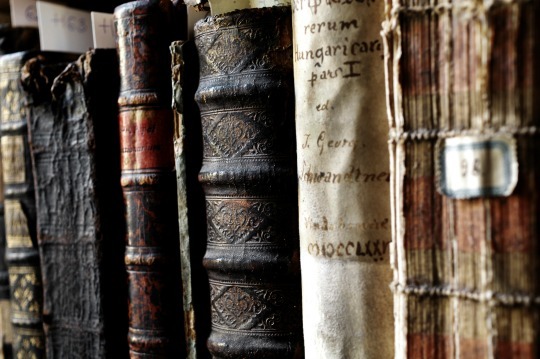
Venetian book production
Book production was a natural art for Venetians, who were already skilled at working with leather, pigments, and gold leaf. Knowledge of paper-making made its way from Asia to Europe during the Middle Ages. Venice, with its strategic location as the gateway to the East, was the natural place for this new art form to take root. From Venice, the tradition of decorative papers moved south to Florence, where it also flourished.
With the widespread use of moveable type instead of script, paper instead of vellum, and woodblock prints and engravings instead of hand-painted illuminations, the interior pages of books were dramatically transformed from their medieval predecessors. However, a book’s exterior, its binding, remained essentially the same as its medieval models. Often, the legatoria only bound a book once a patron purchased it, and therefore the binding was customized and could be as simple or as fancy as the book buyer’s budget and desire.
Early bookbinders discovered that when leather bindings came into direct contact with end papers, the result was discoloration and damage to the paper. They began facing the inside of the leather covers with hand-colored papers. This practice not only meant blank pages for creative and colorful paper displays, but also later the bookbinders realized they could reduce the amount of expensive leather they used in binding. Eventually, many bookbinders began using leather only for the spine, disguising the cover boards with colorful decorative papers.
Venetian marbled paper
The practice of “marbling” paper—decorating paper with colorful patterns that imitate marble veining—probably originated in China. By the fifteenth century these techniques had made their way across East and Central Asia. While the practice of using marbleized end papers was widespread in Germany and France by the seventeenth and eighteenth centuries, most Venetian and other Italian bookbinders used surprisingly little colored decoration, preferring plain, white end papers and foucusing on the leather binding of the book itself. By the mid-eighteenth century, several prominent Venetian bookmakers incorporated marbleized paper into their repertory of woodblock prints, copperplate engraving, leather binding, and other book production services.
The production of Venetian books involved specialists of several stripes—masters of leather, paper, engraving, printing, gilding, and other trades. Many famous Venetian painters, including Tiepolo and Canaletto, produced an enormous number of engravings and etchings during the middle of the eighteenth century, many of which were destined for bound books. Wealthy English travelers on the Grand Tour of Europe fueled demand for individual prints and books that contained prints by these well-regarded artists. These artists’ vedute—or views—of Venice served as precursors to modern-day postcards for these international visitors who wanted to take a piece of Venice home with them.
Have you discovered handmade paper in Venice? Drop a comment below. I love to hear your stories!
 .fusion-fullwidth-1 {
.fusion-fullwidth-1 {
padding-left: 0px !important;
padding-right: 0px !important;
}  Join me!
Join me!
Be the first to receive exclusive content, news, contests, and reader appreciation gifts. Sign up for my Reader’s Group and download a free copy of my guide, How to Go Shopping on Vacation Without Getting Ripped Off.
.fusion-button.button-1 .fusion-button-text, .fusion-button.button-1 i {color:#ffffff;}.fusion-button.button-1 {border-width:0px;border-color:#ffffff;}.fusion-button.button-1 .fusion-button-icon-divider{border-color:#ffffff;}.fusion-button.button-1:hover .fusion-button-text, .fusion-button.button-1:hover i,.fusion-button.button-1:focus .fusion-button-text, .fusion-button.button-1:focus i,.fusion-button.button-1:active .fusion-button-text, .fusion-button.button-1:active{color:#000000;}.fusion-button.button-1:hover, .fusion-button.button-1:focus, .fusion-button.button-1:active{border-width:0px;border-color:#000000;}.fusion-button.button-1:hover .fusion-button-icon-divider, .fusion-button.button-1:hover .fusion-button-icon-divider, .fusion-button.button-1:active .fusion-button-icon-divider{border-color:#000000;}.fusion-button.button-1{background: #dd9933;
background-image: -webkit-gradient( linear, left bottom, left top, from( #c97800 ), to( #dd9933 ) );
background-image: -webkit-linear-gradient( bottom, #c97800, #dd9933 );
background-image: -moz-linear-gradient( bottom, #c97800, #dd9933 );
background-image: -o-linear-gradient( bottom, #c97800, #dd9933 );
background-image: linear-gradient( to top, #c97800, #dd9933 );}.fusion-button.button-1:hover,.button-1:focus,.fusion-button.button-1:active{background: #c97800;
background-image: -webkit-gradient( linear, left bottom, left top, from( #dd9933 ), to( #c97800 ) );
background-image: -webkit-linear-gradient( bottom, #dd9933, #c97800 );
background-image: -moz-linear-gradient( bottom, #dd9933, #c97800 );
background-image: -o-linear-gradient( bottom, #dd9933, #c97800 );
background-image: linear-gradient( to top, #dd9933, #c97800 );}.fusion-button.button-1{width:auto;}GET MY FREE BOOK.fusion-fullwidth-2 {
padding-left: 20px !important;
padding-right: 20px !important;
}Explore my books:



 Learn more about Laura Morelli’s Authentic Arts guidebook series.
Learn more about Laura Morelli’s Authentic Arts guidebook series.
The post Venetian Paper & Bookbinding: A Brief History appeared first on Laura Morelli: Art History, Art Historical Fiction, Authentic Travel.
January 31, 2016
New York Times Travel Show
Working as an author is a solitary pursuit. Being an introvert, I am fine with this most of the time–in fact, I love working as a lone wolf! But… sometimes you need to get out. I love the opportunity to meet travelers and readers. I also love seeing my fellow writers and Italophile experts at these events.
Meet and Greet
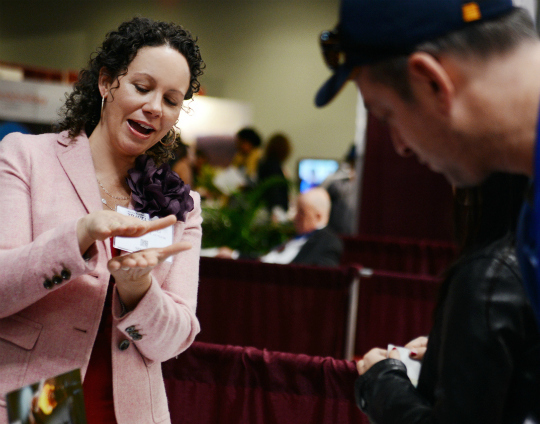
I’m not describing how to make lasagna–I promise! I’m talking with visitors about how Florentine leather is made. Do you know?
Nearly 30,000 people visited the show this year. The Javits Center in New York was packed so I was not surprised to hear those numbers! I talked to many people who were planning return trips to Italy, and some who were planning their first. How exciting! Lots of visitors had questions about where to go and how to come home with authentic souvenirs.
Discover Italy

Discover Italy panel
This year I had the distinct pleasure of being invited to serve on a panel called Discover Italy along with some of the people I most admire. Susan van Allen, author of 100 Places in Italy Every Woman Should Go, kept our group on track and proved a powerful presence at the front of the room even though she described herself to everyone as “vertically challenged.” (In reality, she is precious and vivacious!)
Joining us on the panel were Kathy McCabe, editor of Dream of Italy newsletter and the wonderful public TV series of the same name; Steve Perillo of Perillo Tours, and Jason Spiehler, co-founder of Walks of Italy.

We gave out lots of great raffle prizes, including a signed copy of my book, Made in Italy !
All of us were amazed to walk into the seminar room to find it standing-room only. We had a wonderful group of engaged show-goers and lots of great questions.
Books and more…
After the panel, I got a chance to catch up with more readers, travelers, and colleagues in the book store and signing area, including Arthur and Pauline Frommer of the venerable Frommers travel guide franchise.
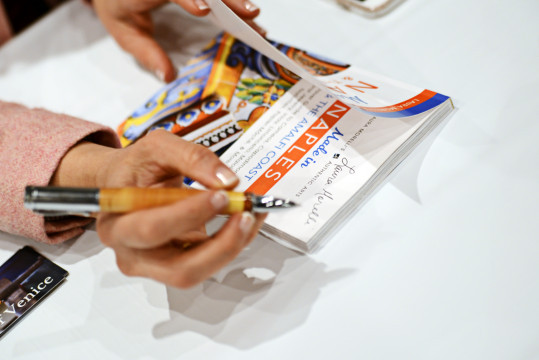
Signing books at the New York Times Travel Show
One very cool thing about going to shows is the chance to meet people in “real life” who I’ve met on Facebook, Twitter, or elsewhere on line.

With Pauline Frommer and Susan van Allen
I’ll be back next year. Hope to see you there!
Have you attended the New York Times Travel Show or another similar show in your city? Drop a comment below. I love to hear your experiences!
All photos and video courtesy of Karina Ordell.
.fusion-fullwidth-1 {
padding-left: 0px !important;
padding-right: 0px !important;
}
 Join me!
Join me!Be the first to receive exclusive content, news, contests, and reader appreciation gifts. Sign up for my Reader’s Group and download a free copy of my guide, How to Go Shopping on Vacation Without Getting Ripped Off.
.fusion-button.button-1 .fusion-button-text, .fusion-button.button-1 i {color:#ffffff;}.fusion-button.button-1 {border-width:0px;border-color:#ffffff;}.fusion-button.button-1 .fusion-button-icon-divider{border-color:#ffffff;}.fusion-button.button-1:hover .fusion-button-text, .fusion-button.button-1:hover i,.fusion-button.button-1:focus .fusion-button-text, .fusion-button.button-1:focus i,.fusion-button.button-1:active .fusion-button-text, .fusion-button.button-1:active{color:#000000;}.fusion-button.button-1:hover, .fusion-button.button-1:focus, .fusion-button.button-1:active{border-width:0px;border-color:#000000;}.fusion-button.button-1:hover .fusion-button-icon-divider, .fusion-button.button-1:hover .fusion-button-icon-divider, .fusion-button.button-1:active .fusion-button-icon-divider{border-color:#000000;}.fusion-button.button-1{background: #dd9933;
background-image: -webkit-gradient( linear, left bottom, left top, from( #c97800 ), to( #dd9933 ) );
background-image: -webkit-linear-gradient( bottom, #c97800, #dd9933 );
background-image: -moz-linear-gradient( bottom, #c97800, #dd9933 );
background-image: -o-linear-gradient( bottom, #c97800, #dd9933 );
background-image: linear-gradient( to top, #c97800, #dd9933 );}.fusion-button.button-1:hover,.button-1:focus,.fusion-button.button-1:active{background: #c97800;
background-image: -webkit-gradient( linear, left bottom, left top, from( #dd9933 ), to( #c97800 ) );
background-image: -webkit-linear-gradient( bottom, #dd9933, #c97800 );
background-image: -moz-linear-gradient( bottom, #dd9933, #c97800 );
background-image: -o-linear-gradient( bottom, #dd9933, #c97800 );
background-image: linear-gradient( to top, #dd9933, #c97800 );}GET MY FREE BOOK.fusion-fullwidth-2 {
padding-left: 20px !important;
padding-right: 20px !important;
}Explore my books:




The post New York Times Travel Show appeared first on Laura Morelli: Art History, Art Historical Fiction, Authentic Travel.
January 15, 2016
Venetian Marbled Paper
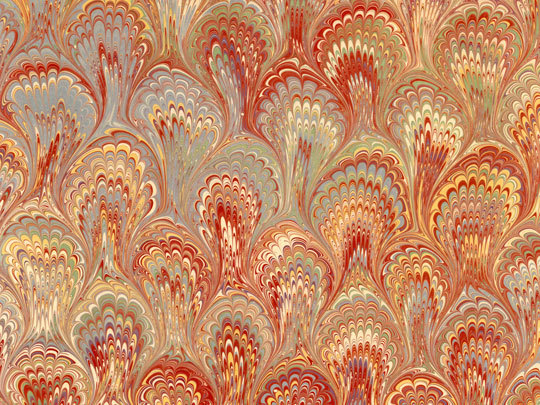
Venetian marbled paper (carta marmorizzata) is made by swirling pigments into a large, shallow pan of water, then laying the paper gently and briefly on the surface of the water to transfer the pattern. Because the designs sometimes mimic the natural veining in stone or marble, the word “marbled” or “marbleized” came to be used.
Marbled paper is made across Asia and Europe, turned out with differing techniques depending on where it is made. In Venice, paper makers traditionally began with viscous oil-based paints well-known to Venetian artists since the late Middle Ages. These pigments, known as size or sizing, derived from various plants, including widely available aquatic ones. Today, many paper artists prefer synthetic acrylics and oil paints. Artists apply the paints into a wide, shallow tray filled with water. Sometimes a surfactant is used to help the colors float on the surface. Traditionally, artists used ox gall to serve this purpose, though today there are synthetic surfactants on the market.
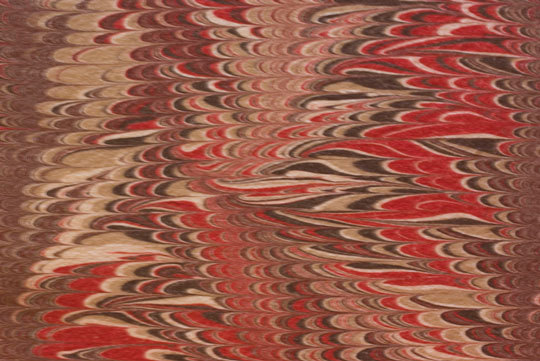
The creative aspect of paper marbling comes next, when the artist applies the colors to the water using any number of techniques—like dropping or splattering paint using paintbrushes, horsehair or straw whisks, or other tools—to apply color to the surface of the water in a particular design or order. After the color has been dropped, the artist may use a variety of tools—including rakes, styluses, combs, brushes, or even a single hair—to create swirls, lines, and other design elements in the paint.
Textile connections
The techniques used to marbleize paper are closely related to the art of batik, laying pigments on fabrics. In fact, some paper artists are also active practitioners of fabric and fashion design.
Traditional Marbled Paper Designs
Much in the same way that Italians name pasta shapes after animals and household objects, some of the most popular marbleized paper designs are inspired by familiar images. Look for these common designs among the legatorie across town:
Chiocciola (snail) or conchiglia (shell)
With a beautiful sense of movement, the shell pattern is made by forming each coil with a stylus. This pattern was used widely in book end papers of the Renaissance period.
Marmo pettinato (combed marble)
This design is created by dragging a rake-like tool through the pigments, disturbing the horizontal lines and giving the impression of having been combed.
Pavone (peacock)
The appearance of peacock feathers is achieved with a special comb and rake. This is one of the most common patterns of paper marbling.
Have you discovered handmade paper and bookbinding in Venice? Drop a comment below. I love to hear your stories!
.fusion-fullwidth-1 {
padding-left: 0px !important;
padding-right: 0px !important;
}
 Join me!
Join me!Be the first to receive exclusive content, news, contests, and reader appreciation gifts. Sign up for my Reader’s Group and download a free copy of my guide, How to Go Shopping on Vacation Without Getting Ripped Off.
.fusion-button.button-1 .fusion-button-text, .fusion-button.button-1 i {color:#ffffff;}.fusion-button.button-1 {border-width:0px;border-color:#ffffff;}.fusion-button.button-1 .fusion-button-icon-divider{border-color:#ffffff;}.fusion-button.button-1:hover .fusion-button-text, .fusion-button.button-1:hover i,.fusion-button.button-1:focus .fusion-button-text, .fusion-button.button-1:focus i,.fusion-button.button-1:active .fusion-button-text, .fusion-button.button-1:active{color:#000000;}.fusion-button.button-1:hover, .fusion-button.button-1:focus, .fusion-button.button-1:active{border-width:0px;border-color:#000000;}.fusion-button.button-1:hover .fusion-button-icon-divider, .fusion-button.button-1:hover .fusion-button-icon-divider, .fusion-button.button-1:active .fusion-button-icon-divider{border-color:#000000;}.fusion-button.button-1{background: #dd9933;
background-image: -webkit-gradient( linear, left bottom, left top, from( #c97800 ), to( #dd9933 ) );
background-image: -webkit-linear-gradient( bottom, #c97800, #dd9933 );
background-image: -moz-linear-gradient( bottom, #c97800, #dd9933 );
background-image: -o-linear-gradient( bottom, #c97800, #dd9933 );
background-image: linear-gradient( to top, #c97800, #dd9933 );}.fusion-button.button-1:hover,.button-1:focus,.fusion-button.button-1:active{background: #c97800;
background-image: -webkit-gradient( linear, left bottom, left top, from( #dd9933 ), to( #c97800 ) );
background-image: -webkit-linear-gradient( bottom, #dd9933, #c97800 );
background-image: -moz-linear-gradient( bottom, #dd9933, #c97800 );
background-image: -o-linear-gradient( bottom, #dd9933, #c97800 );
background-image: linear-gradient( to top, #dd9933, #c97800 );}GET MY FREE BOOK.fusion-fullwidth-2 {
padding-left: 20px !important;
padding-right: 20px !important;
}Explore my books:



 Learn more about Laura Morelli’s Authentic Arts guidebook series.
Learn more about Laura Morelli’s Authentic Arts guidebook series. The post Venetian Marbled Paper appeared first on Laura Morelli: Art History, Art Historical Fiction, Authentic Travel.
December 15, 2015
Leather Shopping in Florence, Italy
The opportunities to buy leather in Florence are vast, from luxury boutiques, to raucous street bazaars, to “private” workshops, to sidewalk trinket sellers. To make matters more confusing, things are rarely what they seem on the surface. You can find a reasonably priced bag on the street whose quality equals an item in a high-end boutique. Other times, the same merchant may sell the same bag in a pelletteria and also in a market stall, at two very different prices. Some pieces are made on an industrial scale, others on an artisanal one, and sometimes the same merchant may sell both. In short, leather shopping in Florence can be very tricky.
How to Choose Quality Leather in Florence
If you’re serious about going home with a quality leather souvenir, you should know a few tricks of the Florentine leather-shopping trade. First, if you can buy directly from the maker, that’s the absolute best guarantee of knowing exactly what you’re buying. However, in Florence buying leather directly from an artisan is only easy when buying small, portable items like boxes, wallets, and change purses. Most apparel items are sold in small retail shops. In this case, what you buy is more important than where you buy. Try to divorce the handbag or jacket from its setting if you can and focus instead on the quality of the individual piece.
When it comes to judging leather quality, try to forget whether you’re in a bustling street market or a high-end boutique. Instead, let the buying environment fade out of focus, and use your senses:
Aroma: When it comes to judging leather, follow your nose. The item should smell musky and natural. Steer clear of anything that smells like chemicals, which are used to treat the hides and cover up lesser quality. Your sense of smell and touch will help determine the quality of the leather. The more supple the leather feels, the better. If an acrid, chemical smell assaults you when you enter the shop, chances are the goods are heavily dyed to disguise lesser-quality bonded leather. A wonderful, earthy aroma characterizes natural leather.
Suppleness: The leather should feel smooth, supple, and soft, not stiff.
Color: The highest quality natural leather in tan or brown can stand on its own, without any added color, to reveal the natural grain and beauty of the material. Dyes, in red or green, for example, can mask lesser quality leather. If the edges of the leather are unfinished, you should be able to tell if the color lies on the surface or penetrates all the way through the hide. If you buy a blue bag, for example, you may only see blue on the surface, not in the middle. If that’s the case, chances are, this is bonded leather whose surface has been sprayed with dye, perhaps to resemble a grain-like “natural” pattern.
Stitching and other details: The stitching should be tight and regular, with small stitches sewn close together. Silk or satin lining is used in higher-quality bags and apparel.
Where to buy Florentine leather
San Lorenzo Market
The San Lorenzo market attracts leather-shopping visitors from Tokyo to Tulsa, with its pulsating rhythm, the chatter of bargaining merchants, the bustle of the crowd, and the musky aroma of leather wafting into the air. The market itself includes an indoor section known as the Mercato Centrale, which sells mostly food items, while the outdoor market is known for leather. You will not necessarily find the lowest prices or the best quality here, but I have still scored some good-quality finds, including a classic brown jacket I bought a decade ago that still looks great. Many of these street vendors also operate retail stores. Their street-side stalls are just another venue for generating sales, without the overhead of a shop. That’s how you might find the same item with two or more different prices.
Mercato Nuovo
Another popular leather-shopping spot is the Mercato Nuovo, also known as the “porcellino” market for the bronze pig whose nose has been rubbed smooth by superstitious travelers to guarantee a future trip to Florence. During the Renaissance, wealthy Florentines shopped for gold and silk under the arcades of this beautiful marketplace. Later, it became known for straw vendors. Today, leather takes center stage in the Mercato Nuovo. As in the San Lorenzo market, quality and price vary widely. This is one of the trickiest places to shop in Florence, so be sure to use your skills of distinguishing higher from lower quality in order to ensure you make a purchase you’ll still be happy about when you get home.
STREET BAGSWhatever you do, do not buy a “brand name” handbag in Florence from someone selling it on a blanket spread out on the sidewalk. This advice may seem like common sense, but tantalizingly cheap prices lure visitors into this trap every day. For Italian authorities, this scam is considered serious business, as the brand-name leather trade is a major driver of the Italian economy. In recent decades, authorities have cracked down with greater force on vendors selling knockoff bags to buyers who either don’t know the difference or are more than happy with a low-priced imitation. I have seen women purchase handbags on the street, only to turn around and have to hand over the bags directly to uniformed carabinieri waiting for the transaction to close. These customers do not get their money back; it’s just not worth it.
How much to pay
Bargaining is the norm in the markets and I have found that you can easily take off ten to twenty percent simply by asking, or by plying some tried-and-true haggling techniques such as offering to pay cash, buying more than one item at the same time, or just walking away. Talented hagglers might get the price down to half. In shops, bargaining is less common and usually less successful, but it never hurts to ask.
One of the market vendors may extend you an “exclusive invitation” to visit their “private” leather workshop. Yes, these are mostly gimmicks geared toward making tourists think they’re getting the deal of a lifetime. Here’s how it works: You follow a high-pressure salesman (truthfully, it’s usually a charming, handsome Italian man) to an unmarked door down a side street. There you encounter a no-frills warehouse-type setting chock full of leather apparel, and perhaps a few more handsome Florentines. They’ll help you try on jackets before a mirror, all the while asking if all American women are as beautiful as you. Impressive sales tactics, no doubt.
What you pay depends mostly on where you buy. I priced a popular type of medium-sized shoulder bag in several places around the city. A street vendor near Santa Croce carried the style I wanted and I bargained him down to about thirty-five percent off the original asking price, but the stitching was beginning to fray and the leather felt stiff, so I passed. A similarly styled bag in a high-end boutique near the Duomo—this one of great quality with soft leather, silk lining, and fine stitching—was exorbitantly priced. In the end, I found a winner, the quality equal to the higher-priced bag, in an unassuming boutique on a less-trafficked street. This experience is typical of Florentine leather shopping. Some visitors find the experience confusing or exasperating, while others relish the thrill of the hunt.
As a general rule, Florentine leather goods are not cheap, but often represent a good value considering the quality. The safest bet is to buy directly from the maker and to focus on small, portable items—boxes, change purses, eyeglass cases, albums, desk accessories—rather than apparel, which is more complex and tricky to get right. Many of these small items are completely handmade on site, and the prices are typically reasonable. They also make durable souvenirs and special gifts that are either easy to transport in your suitcase or relatively simple to ship.
Have you discovered something wonderful in Florence? Drop a comment below. I love to hear your stories!

Join me!
Be the first to receive exclusive content, news, contests, and reader appreciation gifts.
Sign up for my Reader’s Group and download a free copy of my guide, How to Go Shopping on Vacation Without Getting Ripped Off.#wrapper .fusion-button.button-1{text-shadow:none;-webkit-box-shadow:none;-moz-box-shadow:none;box-shadow: none;border-width:0px;color:#ffffff;border-color:#ffffff;}#wrapper .fusion-button.button-1:hover,.fusion-button.button-1:focus,.fusion-button.button-1:active{border-width:0px;border-color:#000000;color:#000000;}#wrapper .fusion-button.button-1{background: #dd9933;
background-image: -webkit-gradient( linear, left bottom, left top, from( #c97800 ), to( #dd9933 ) );
background-image: -webkit-linear-gradient( bottom, #c97800, #dd9933 );
background-image: -moz-linear-gradient( bottom, #c97800, #dd9933 );
background-image: -o-linear-gradient( bottom, #c97800, #dd9933 );
background-image: linear-gradient( to top, #c97800, #dd9933 );}#wrapper .fusion-button.button-1:hover,.button-1:focus,.fusion-button.button-1:active{background: #c97800;
background-image: -webkit-gradient( linear, left bottom, left top, from( #dd9933 ), to( #c97800 ) );
background-image: -webkit-linear-gradient( bottom, #dd9933, #c97800 );
background-image: -moz-linear-gradient( bottom, #dd9933, #c97800 );
background-image: -o-linear-gradient( bottom, #dd9933, #c97800 );
background-image: linear-gradient( to top, #dd9933, #c97800 );}GET MY FREE BOOK
Explore my books:
.imageframe-2 img{border:1px solid #bfbfbf;} 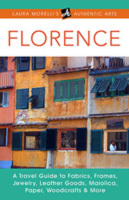 .imageframe-3 img{border:1px solid #bfbfbf;}
.imageframe-3 img{border:1px solid #bfbfbf;}  .imageframe-4 img{border:1px solid #bfbfbf;}
.imageframe-4 img{border:1px solid #bfbfbf;} 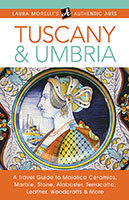 .imageframe-5 img{border:1px solid #bfbfbf;}
.imageframe-5 img{border:1px solid #bfbfbf;} 
Learn more about Laura Morelli’s Authentic Arts guidebook series.
The post Leather Shopping in Florence, Italy appeared first on Laura Morelli: Art History, Art Historical Fiction, Authentic Travel.
November 15, 2015
John Ruskin and Venice: Guest Post by Author Octavia Randolph
This month I am pleased to welcome my fellow author, medievalist, and Venetophile friend Octavia Randolph. Octavia has written a fantastic series of historical novels set in 9th-century England and Scandinavia, the Circle of Ceridwen Saga . Most recently, her historical novel, Light, Descending , draws us into the mind of one of the most fascinating figures of the nineteenth century: the artist and art critic John Ruskin. Ruskin, a passionate lover of Venice, captured the city in a series of lovely watercolors. But it is Ruskin’s obsessive and flawed character that holds us captive in Octavia’s beautiful new book. Here’s a taste:
John Ruskin was one of the great figures of the 19th century, one of the truly seminal thinkers on art, architecture, and social justice. I’d like to share with you some thoughts on his relationship with Venice, which he believed was the world’s supreme architectural and cultural expression, or as he said, Venice was “the history of all men, not in a nutshell, but in a nautilus shell.”
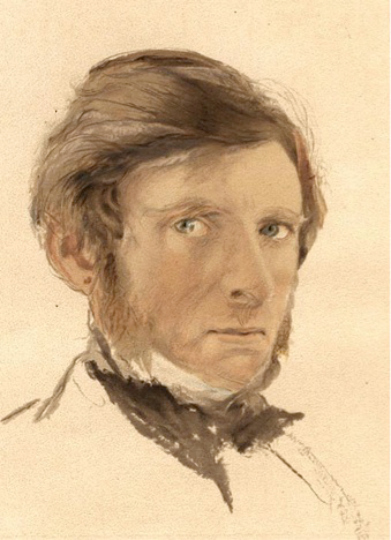
Self-portrait, John Ruskin, age 42
The life of John Ruskin exactly mirrored that of Queen Victoria. They were both born in 1819, and died a year apart, he in 1900 and she in 1901. Ruskin had a decidedly bifurcated career; the first half of which was largely devoted to thinking and writing and lecturing about art and architecture, of which his greatest and most lasting contribution was The Stones of Venice, a magisterial work on the history of La Serenissima, told through its architecture.
Much of the second half of his career was devoted to issues of social and economic justice. In 1906, six years after Ruskin’s death, the incoming Labour Members of Parliament were polled as to whose books were most influential in their personal development, and Ruskin’s books ranked first, besting those of the Bible, Shakespeare, Dickens, Carlyle and many others. In other words, he left a profound impact on society a century ago.
Ruskin spent about 18 months of his life living in Venice. From boyhood on he travelled every Summer on the Continent with his parents, and the first time he saw Venice he was 16; they stayed there a week.
As a 22 year old Ruskin returned to Venice. After furiously drawing all he could see, he felt overwhelmed at his inability to capture the city. He wrote to an Oxford friend, “I have put up my pencils, rather sulkily, by the bye: for this place is quite beyond everybody but Turner.” The great JMW Turner, was of course, Ruskin’s life-long hero, whose cause Ruskin championed for his entire life.
He returned in a later drawing trip, spending September and October 1845 there, a trip on which he made many of his most beautiful and expressive record drawings. Venice was very much under assault, in Ruskin’s view, by this time. The occupying Austrians (Napoleon had seized it and looted it in 1797, and then handed it over to the Austrians) had nearly completed the causeway from the mainland, put in gas lighting, and as he wrote in despair to his father, “After whitewashing the Doge’s palace…they are scraping St Mark’s clean. Off go all the glorious old weather stains, the rich hues of the marble which nature, mighty as she is, has taken ten centuries to bestow.” And, “It is misery for me to stop here, but every hour is destructive of what I most value, and I must do what I can to save a little.” He was saving it of course, by drawing it, recording it.
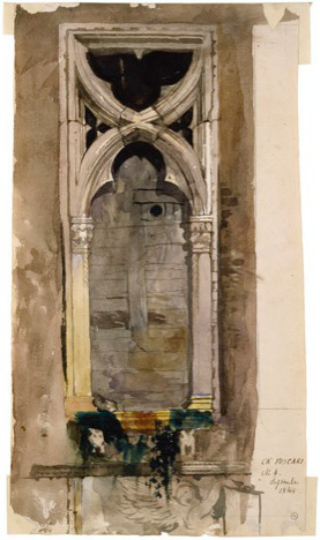
Ca’ Foscari, John Ruskin
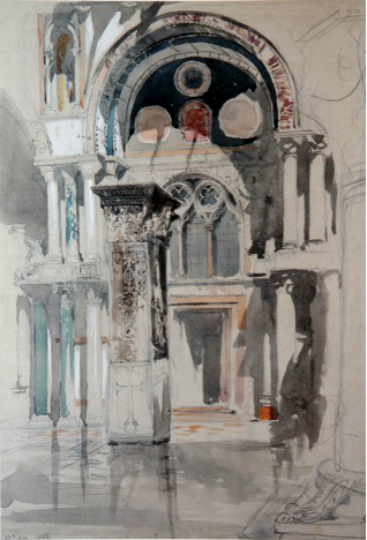
Part of St Mark’s Basilica – the South side of the Baptistery, John Ruskin
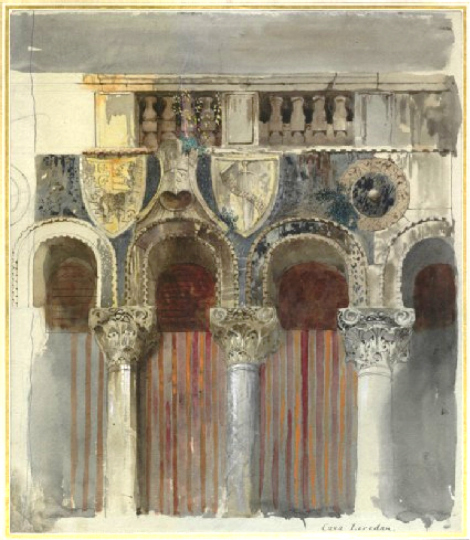
Casa Loredan, John Ruskin
Of the Casa Loredan, also called Palazzo Corner-Loredan, Ruskin said “which will, I believe, be felt at last, by all who examine it carefully, to be the most beautiful palace in the whole extent of the Grand Canal.” This was what Ruskin saw and recorded in 1845; by 1867 the building became a municipal office, and was stripped of the colour and detail that Ruskin had cherished.
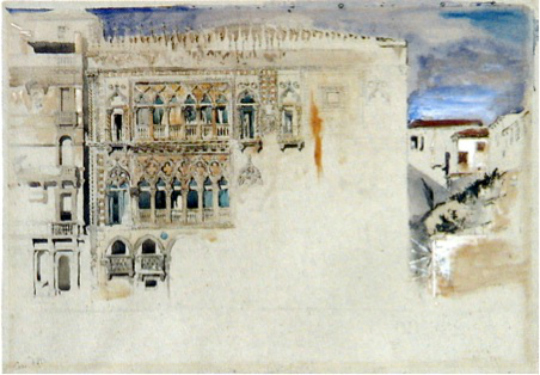
Ca’d’Oro, John Ruskin
Marie Taglioni owned the Ca’ d’Oro when Ruskin witnessed it, during that 1845 visit, being set upon by “restorers” chiselling off the very cabled ornament he was furiously attempting to draw; the prima ballerina was modernizing the house and sold off bits and pieces of Ca’ d’Oro, including the huge interior marble stair, said to have been the most exquisite in Venice.
But the trip that mattered most, the trip that he had a true mission for, was in fact his delayed wedding trip to Venice, with his young Scottish wife Effie Gray. They spent two winters there. The first four months they lived there, beginning in October 1849 were truly revelatory to Ruskin.
What was he doing in Venice? – he wished to document its monuments for what would eventually become the three volume Stones of Venice – going to this den of inequity – Venice – much against his father’s wishes (and his father underwrote everything Ruskin ever did, every trip he took, every painting he ever bought, and it was terrifically hard for John to defy him as he was so dependent on him.)
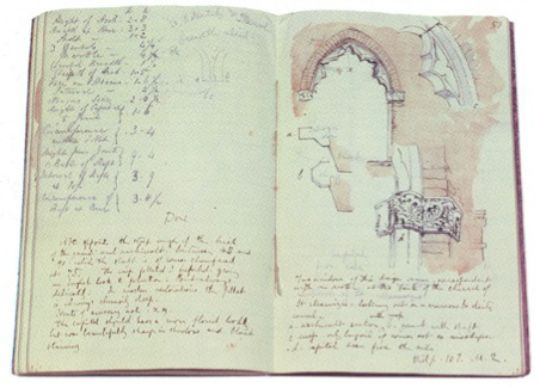
One of Ruskin’s pocket notebooks; this is Casa Loredan again.
There are two important quotes about The Stones of Venice which bear both repeating and reflection. William Morris called On the Nature of Gothic, the piece nestled in the heart of Volume II…“one of the most important things written by the author, and in future days will be considered as one of the very few necessary and inevitable utterances of the century.” Henry James said of The Stones of Venice, “Ruskin has made Venice his own, and in doing so, has made her the world’s.”

Cornice Decoration study, 1851, John Ruskin
These are the kind of detailed studies that Ruskin did that prompted a later observer to note that if Venice were ever destroyed, it could practically be reconstructed through Ruskin’s meticulous drawings.
In wasn’t entirely all work, especially during the second winter Ruskin and Effie spent in Venice. Ruskin usually asked Effie to go out without him at night, but during Carnivale she wrote to her mother, “I am rather tired today as I was up late last night, John and I having taken it into our heads that we would mask and have some fun…We hired a couple of dominoes [these are enveloping cloaks], black with black masks and white gloves, and reached the square about ten. I laughed so that I could scarcely go on and John, who was a grave as possible, did the thing capitally. We found quantities of masks in dominoes and fancy costumes of all kinds parading about and entering the Cafes to throw bonbons…”
Despite such moments of revelry, we know the five year marriage to Effie remained unconsummated. Effie had hoped that going to Venice in the second year of her marriage would in fact signal the beginning of the physical marriage, but it did not. However, one can easily see from reading Effie’s letters that the time she spent with John in Venice was much the happiest of their entire relationship – due not only to the charms of La Serenissima, but the fact that it was one of the few times when the elder Ruskins were not also with them.
One of Ruskin’s biographers, John Batchelor, actually posits, and I think with cause, that Ruskin’s displaced sexual drive found expression in his lust and love for Venice. Venice becomes a love object for him. Certainly both in The Stones of Venice and in letters to his father he uses deeply sensual language to describe his attraction and attachment to the city – he must eat it, devour it, stone by stone. And certainly no beloved ever caused its lover more pain than Venice caused Ruskin.
So. Let’s consider Ruskin’s Venice. As difficult as it is for us to imagine, Venice was not universally admired by the Victorian traveller; it was altogether too ornate, unexpected, and visually chaotic for many. And perhaps it also offended Victorian moral sensibilities; as historian J.G Links points out, “You might see it as a robber’s den, for everything in it was stolen.”
The fact was that Venice, although it had always attracted a certain number of pleasure-loving aristocrats, did not entice the upper-middle classes until The Stones of Venice spelled out her charms and drove home the necessity of experiencing this fabulous mishmash of architectural styles and moral lessons in person. And even then it took some time. Volume I of Stones came out in March 1851, and sold few copies. Volumes II and III came out two years later, in 1853, and then people began to take notice, and of course, On the Nature of Gothic was in volume II. A reviewer in The Daily News noted that no longer could Venice be looked at as an example of “barbarous” taste, with St Mark’s a mass of “ill shaped domes; its walls of brick incrusted with marble; its chaotic disregard of symmetry in the details; its confused hodge-podge of classic, Moresque, and Gothic.” Ruskin had proved that the architects and builders of the middle ages were “artists of profound and tender feelings.”
Ruskin called himself a “foster child of Venice”, and felt both responsible for and frustrated with it, much of the frustration due to the fact that the Republic had destroyed itself, and he could not save the remaining architectural fragments of its illustrious past.
By his late 50’s Ruskin was deeply troubled by the influx of tourists he thought himself accountable for; during his long over-wintering stay of 1876-77 he removed himself from the Grand Hotel to the modest Calcina on the Zattere to escape those hordes who only milled about San Marco and never penetrated into any of the fascinating calles and narrow, backwater canals. And in fact in his 1877 Guide to the Pictures in the Accademia he argues that people should actually be made to pay a fee to enter Venice.
When Ruskin returned to Venice to over-winter there from1876-77 it was after an absence of 16 years; he hadn’t been there since his last trip with Effie in 1852. Now, struggling with mental illness, he was preoccupied with two other young women: St Ursula, and Rose LaTouche. Ursula, the virgin martyr who is the subject of the series of beautiful paintings by Carpaccio in the Accademia, held Ruskin in thrall in his later years. In 1858 Ruskin had met ten year old Rose LaTouche, and over the years proceeded to fall violently in love with her, an obsession which caused both of them great pain. Rose died in May 1875, when she was 27, and the Virgin Rose and the Virgin Ursula became one love-object for him.
Venice, along with Turner, was truly a constant in Ruskin’s life, inspiring his greatest work, and haunting his dreams. He writes much about Venice in the Brantwood diary, the diary in which he documents his own psychotic break in 1878s, as he slipped into the abyss. Such is the abiding power of the Most Serene Republic.
–Octavia Randoph

Octavia Randolph’s most recent work is the biographical novel about John Ruskin, Light, Descending. She is also the author of the best-selling historical adventure Circle of Ceridwen Saga, set in 9th century England and Scandinavia, and the novellas Ride: The Story of Lady Godiva, and The Tale of Melkorka. Visit her at octavia.net.
The post John Ruskin and Venice: Guest Post by Author Octavia Randolph appeared first on Laura Morelli: Art History, Art Historical Fiction, Authentic Travel.
October 15, 2015
Maiolica from Umbria
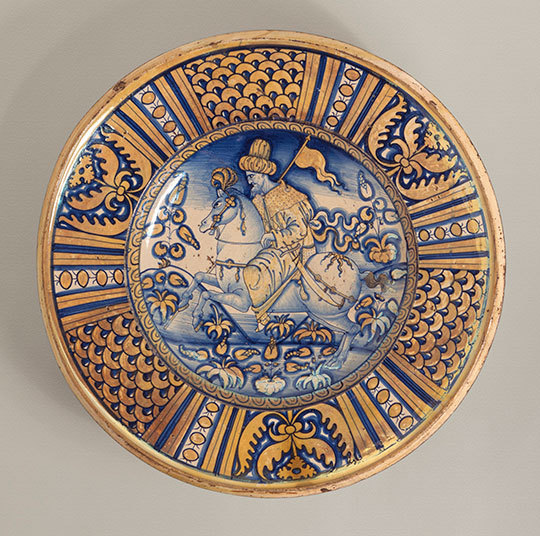
Exquisitely painted some five centuries ago, a small brown stag appears to leap from the clay fragment I hold in my hand. Gingerly, I return it to its owner, the master of one of Deruta’s most historic ceramics workshops. He places the delicate shard inside a glass cabinet at the back of his shop, a vitrine filled with hundreds of vestiges depicting rabbits, cupids, nobles in profile, swags, and swirls. This curio cabinet is not a museum, the master emphasizes with a pointed finger, but the very lifeblood of his workshop. The past is a constant muse for his shop assistants, who work with a fragment at their table to ensure that the spirit of tradition is infused into each piece they produce.
The Spirit of the Past
The past—especially the Renaissance—lives in Umbria, in its brightly colored maiolica ceramic wares, considered synonymous with Mediterranean style. Maiolica is another name for tin-glazed earthenware, made by bathing clay vessels in a glaze that incorporates tin oxides. The technique imparts a bright, opaque white surface that serves as a blank canvas for painted decoration. (Maiolica is often called majolica in English-speaking countries; the latter term also describes a particular class of ceramics produced mainly in England in the 1800s.) The hallmark of maiolica is brightly hued pigments like blue, green, and ocher—a distinctive mix of yellow and orange—painted against this creamy white background.
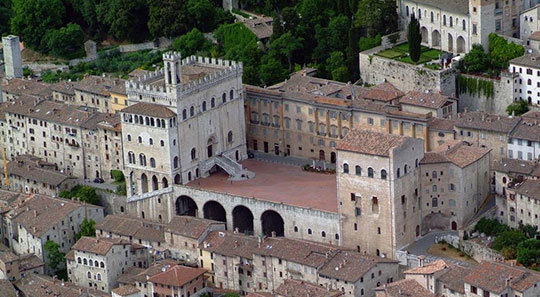
The ceramics capital of Gubbio (courtesy Benessere Umbria, CC via Flickr)
Although maiolica is produced across the Mediterranean, what’s characteristic about Umbrian maiolica is its allegiance to styles of the Renaissance, when the tradition was at its height. In the 15th and 16th centuries, European nobles coveted ceramic gifts commemorating engagements, marriages, and political alliances. Prosperous merchants and noble families, especially in the Tuscan towns of Florence and Siena, fueled demand for maiolica and kept artisans across central Italy busy for several centuries. Umbrian merchants established export routes for their ceramic wares, which were prized across Europe for their intrinsic beauty, craftsmanship, and especially, as markers of social status. A litany of vessel types developed, from simple table services to footed coppe amatorie (“friendship cups”) to brocconi (large pitchers), and specialized wares such as wedding plates that were reserved for display only, or da pompa. Pharmacies commissioned vast quantities of jars called albarelli with the medicinal contents written in elaborate script on the outside of the vessel.
How to Shop for Umbrian Maiolica
To locate the best value in authentic Umbrian ceramics, avoid the temptation to buy in heavily touristed cities like Florence, where you’re sure to pay more. Instead, venture to one of the picturesque hill towns of central Umbria and connect with the artisans themselves. With some 125 active producers of maiolica today, Deruta remains the undisputed capital of Umbrian ceramics, but other nearby towns boast important ceramic traditions, including Gualdo Tadino, Gubbio, and Orvieto. In some workshops, you can observe maiolica made in traditional ways. These wares begin with raw clay pulled from the ruddy hillsides and prepared for throwing on the potter’s wheel or hand-building. Once formed, the vessels are fired, then tin-glazed. After colors are applied, usually with a fine paintbrush, the wares are fired a second time. Sometimes kilns were cavernous rooms, often underground, but today virtually all the makers use modern electric versions.
Although reproductions of Renaissance wares count among the most authentic souvenirs you can purchase, several additional distinctive traditions make for genuine Umbrian finds. Stunning vessels called buccheri are all-black wares achieved by evacuating oxygen from the kiln, a special technique that the ancient Etruscans discovered—probably by accident—in the seventh century B.C. Those with more ornate taste will appreciate maiolica made in Gualdo Tadino, with gilding and frilly edges, made popular in the 19th century. In Gubbio, wares fashioned after the famous historiated or “storytelling” pieces crafted in the 1500s by Master Giorgio Andreoli make an authentic souvenir.
How to Spot Quality Wares
The largest differentiator of quality in Umbrian ceramics lies in the execution of the painted decoration. Unfortunately, many pieces are dashed off for the tourist trade, and you must look carefully and compare details like swirls, fruit, and swags to make sure you’re buying a quality piece. If you need help to train your eye toward richer, more quality painting, spend some time examining historical wares in one of the excellent regional museums, like the Museo Regionale della Ceramica in Deruta. A handful of artisans with a deep respect for the tradition produce wares with an insistence on these local materials, colors, shapes, decorative patterns, and fine painting.
Quality pieces of Umbrian ceramics do not come cheap, but you will still spend less in the hill towns of Umbria than if you buy a piece of similar quality in the U.S. Shipping can be costly, though many producers are set up to ship their wares abroad safely. You can even commission an artisan to craft a personalized table service for you, a great idea for newlyweds or anyone who wants a truly unique Umbrian souvenir made to order.
This piece originally appeared in Laura Morelli’s column, “The Genuine Article,” for National Geographic Traveler Online. Click here for more…
Have you discovered Italian ceramics during your travels? Drop a comment below. I love to hear your stories!
Be the first to receive exclusive content, news, contests, and reader appreciation gifts. Sign up for my Reader’s Group and download a free copy of my guide, How to Go Shopping on Vacation Without Getting Ripped Off.#wrapper .fusion-button.button-1{text-shadow:none;-webkit-box-shadow:none;-moz-box-shadow:none;box-shadow: none;border-width:0px;color:#ffffff;border-color:#ffffff;}#wrapper .fusion-button.button-1:hover,.fusion-button.button-1:focus,.fusion-button.button-1:active{border-width:0px;border-color:#000000;color:#000000;}#wrapper .fusion-button.button-1{background: #dd9933;
background-image: -webkit-gradient( linear, left bottom, left top, from( #c97800 ), to( #dd9933 ) );
background-image: -webkit-linear-gradient( bottom, #c97800, #dd9933 );
background-image: -moz-linear-gradient( bottom, #c97800, #dd9933 );
background-image: -o-linear-gradient( bottom, #c97800, #dd9933 );
background-image: linear-gradient( to top, #c97800, #dd9933 );}#wrapper .fusion-button.button-1:hover,.button-1:focus,.fusion-button.button-1:active{background: #c97800;
background-image: -webkit-gradient( linear, left bottom, left top, from( #dd9933 ), to( #c97800 ) );
background-image: -webkit-linear-gradient( bottom, #dd9933, #c97800 );
background-image: -moz-linear-gradient( bottom, #dd9933, #c97800 );
background-image: -o-linear-gradient( bottom, #dd9933, #c97800 );
background-image: linear-gradient( to top, #dd9933, #c97800 );}GET MY FREE BOOK
Explore my books:
.imageframe-2 img{border:1px solid #bfbfbf;}  .imageframe-3 img{border:1px solid #bfbfbf;}
.imageframe-3 img{border:1px solid #bfbfbf;}  .imageframe-4 img{border:1px solid #bfbfbf;}
.imageframe-4 img{border:1px solid #bfbfbf;} 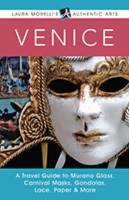 .imageframe-5 img{border:1px solid #bfbfbf;}
.imageframe-5 img{border:1px solid #bfbfbf;} 
Learn more about Laura Morelli’s Authentic Arts guidebook series.
The post Maiolica from Umbria appeared first on Laura Morelli: Art History, Art Historical Fiction, Authentic Travel.

